"Cherishing Little Steps - A Haven for Baby and Family Journeys"
Car Seat Safety for Newborns
Are you a new parent concerned about the safety of your precious newborn while traveling in a car? Look no further! This guide will provide you with essential information and tips on ensuring car seat safety for your little one.
By understanding the importance of car seat safety, choosing the right car seat, and mastering proper installation techniques, you can confidently protect your newborn during every car ride.
We will also discuss securing your baby in the car seat, safety tips for long journeys, and transitioning to a different car seat as your child grows.
Stay up-to-date with the latest car seat safety standards to ensure your baby’s well-being.
Let’s embark on this journey together, keeping your newborn safe and sound on the road ahead.
Key Takeaways
- Proper installation and use of a car seat is crucial for newborn safety
- Choosing a car seat that meets high safety standards and provides optimal protection is important
- Rear-facing car seats provide optimal protection for a baby’s head, neck, and spine
- Reading the car seat manual thoroughly and regularly checking the installation are essential for ensuring your child’s safety
Importance of Car Seat Safety
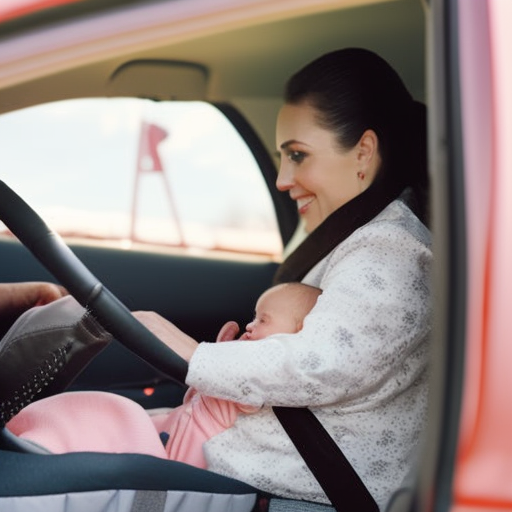
Why is car seat safety so important for you and your newborn?
Ensuring the proper installation and use of a car seat is crucial for the safety of your precious little one. Car accidents are unfortunately common, and the impact of a crash can be severe, especially for newborns who are more vulnerable. A properly installed car seat can significantly reduce the risk of injury or even death in the event of a collision.
Proper car seat installation techniques are essential to maximize the safety benefits. It’s crucial to read the car seat manual thoroughly and follow the manufacturer’s instructions carefully. The seat should be securely installed using either the vehicle’s seat belt or the LATCH system. The straps should be snugly adjusted, with the chest clip positioned at armpit level. It’s crucial to regularly check and ensure that the car seat is correctly installed and that all belts and straps are properly fastened.
Choosing the Right Car Seat

When selecting a car seat for your newborn, it’s important to choose one that meets the highest safety standards and provides optimal protection. There are various car seat brands available in the market, each offering different features to ensure your baby’s safety during car rides.
Firstly, consider the type of car seat suitable for your newborn. Infant car seats are designed specifically for newborns and are rear-facing. They come with a detachable carrier, allowing you to easily move your baby in and out of the car without disturbing their sleep. Convertible car seats, on the other hand, can be used for both infants and toddlers. They can be used in a rear-facing position for newborns and then converted to a forward-facing position as your child grows older.
When choosing a car seat, look for features such as a five-point harness system, side-impact protection, and easy installation. The five-point harness system ensures that your baby is securely strapped in, reducing the risk of injury in the event of a crash. Side-impact protection provides additional protection for your baby’s head and neck. Easy installation features, like LATCH connectors or a simple seatbelt installation system, make it easier for you to correctly install the car seat.
It is also essential to consider the weight and height limits of the car seat, as your newborn will quickly outgrow it. Choose a car seat that will accommodate your baby’s growth for an extended period of time.
Understanding Rear-Facing Positioning
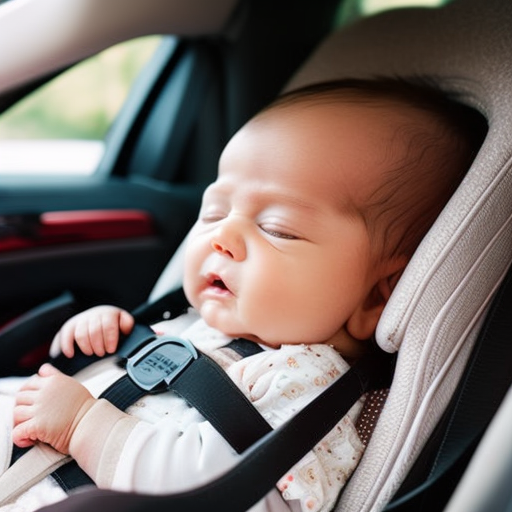
To ensure the highest level of safety for your newborn, position their car seat in the rear-facing direction. Rear facing car seats offer numerous benefits and are recommended by experts for infants up to a certain age or weight. By facing the back of the vehicle, the car seat provides optimal protection for your baby’s head, neck, and spine in the event of a collision. This is because the force of impact is distributed evenly across the entire seat, reducing the risk of injury.
The American Academy of Pediatrics (AAP) recommends keeping your child in a rear-facing car seat until they reach the maximum weight or height allowed by the manufacturer. This is usually around two years old or when they outgrow the seat’s weight or height limits. It’s important to follow the rear-facing guidelines set by the car seat manufacturer to ensure your child’s safety.
Rear-facing car seats have been proven to significantly reduce the risk of serious injury or death in the event of a car crash. Research shows that children in rear-facing car seats are five times safer than those in forward-facing seats. This is why it’s crucial to keep your child rear facing for as long as possible, even if they seem uncomfortable or complain. Remember, their safety is the top priority.
Proper Installation Techniques

To ensure your newborn’s car seat is properly installed, you need to follow these recommended techniques. Proper installation is crucial for the safety of your child while traveling in a vehicle.
One of the most common mistakes parents make isn’t reading the car seat manual thoroughly. Each car seat has specific installation instructions that must be followed precisely.
Start by positioning the car seat in the rear-facing position, as discussed in the previous section. Make sure the seat is securely attached to the vehicle using either the seat belt or the lower anchors and tethers for children (LATCH) system.
Check for a tight fit by giving the car seat a firm tug at the base. Additionally, ensure the harness straps are properly adjusted and snugly secured around your baby. Avoid bulky clothing that can interfere with the harness’s ability to restrain your child effectively.
Lastly, double-check that the car seat doesn’t move more than an inch in any direction. Regularly inspect the installation to catch any issues early on and ensure your newborn’s car seat is always correctly installed.
Securing Your Newborn in the Car Seat
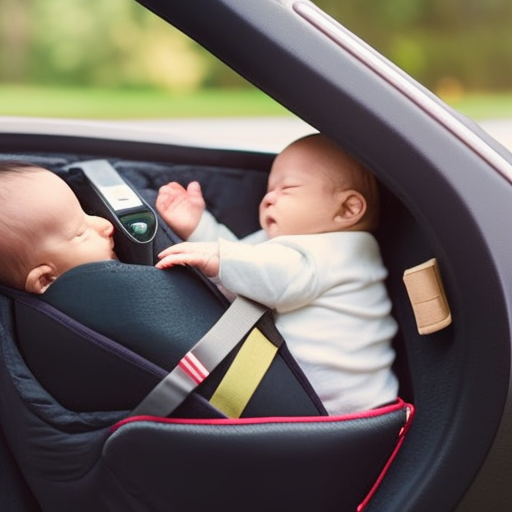
Secure your newborn in the car seat by following these essential steps:
-
Use newborn car seat accessories: To ensure a snug and secure fit for your little one, consider using newborn car seat accessories such as head supports, harness pads, and strap covers. These accessories provide added comfort and support, especially for premature babies who may need extra cushioning.
-
Adjust the harness straps: The harness straps should be positioned at or below your baby’s shoulders. Make sure the straps are snug, but not too tight, allowing for proper breathing and movement. Remember to remove any bulky clothing or blankets that can interfere with the harness’s effectiveness.
-
Check the angle of the car seat: For newborns, it’s crucial to have the car seat reclined at the correct angle. Most car seats have an indicator or level that shows the appropriate recline position. Ensure that the car seat is reclined enough to support your baby’s head and neck, as this helps prevent their head from falling forward.
By following these steps, you can provide your newborn with a safe and secure car seat experience.
Adjusting the Harness for a Snug Fit

Now, let’s make sure your baby is properly secured by adjusting the harness for a snug fit.
Adjusting the harness tightness is crucial to ensure your newborn’s safety in the car seat. To start, make sure the harness straps are at or below your baby’s shoulders. This ensures proper strap placement and reduces the risk of injury in the event of a crash.
Next, check the tightness of the straps by performing the pinch test. With the harness buckled, try to pinch the strap at your baby’s shoulder. If you can pinch any excess fabric, the straps are too loose and need to be tightened.
Proper strap placement and adjusting harness tightness are essential for your baby’s protection. Remember to snugly secure the harness without over-tightening, as this can cause discomfort for your little one.
Regularly check the harness to ensure it remains snug and secure as your baby grows. By following these guidelines, you can provide a safe and comfortable ride for your newborn.
Positioning the Car Seat in the Vehicle

Properly position the car seat in your vehicle to ensure the safety of your newborn. Car seat installation and placement are critical in providing optimal protection for your little one. Follow these steps to ensure the correct positioning of your car seat:
-
Read the car seat manual: Familiarize yourself with the installation instructions provided by the car seat manufacturer. Each car seat may have specific requirements and guidelines for installation.
-
Choose the rear-facing position: It’s recommended to install the car seat in the back seat of the vehicle, preferably in the middle. This provides the most protection in the event of a side impact crash.
-
Secure the car seat tightly: Use either the vehicle’s seat belt or the lower anchors and tether system (LATCH) to secure the car seat. Ensure that the car seat is firmly anchored and doesn’t move more than an inch in any direction.
By following these steps, you can ensure that your car seat is properly installed and positioned, providing the utmost safety for your newborn.
Remember to regularly check and adjust the car seat’s installation to ensure it remains secure. Your little one’s safety is of utmost importance, and proper car seat placement is a crucial part of keeping them protected during car rides.
Addressing Common Car Seat Installation Mistakes
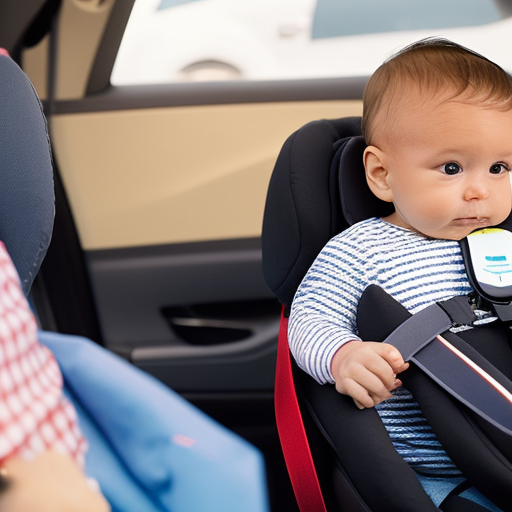
To ensure the safety of your newborn, it’s important to address any common mistakes made during car seat installation. Installing a car seat may seem straightforward, but there are several common car seat installation errors that parents often make. By being aware of these mistakes and taking the necessary steps to avoid them, you can ensure that your newborn is properly secured in their car seat.
One of the most common car seat mistakes isn’t properly tightening the seat belt or using the LATCH system. It’s essential to follow the manufacturer’s instructions and ensure that the car seat is securely fastened to the vehicle.
Another mistake isn’t using the appropriate recline angle for your baby’s age and size. Most car seats have multiple recline positions to accommodate newborns, and it’s crucial to adjust it correctly.
Additionally, not using the chest clip correctly is another common error. The chest clip should be positioned at armpit level to secure the harness straps properly. Many parents make the mistake of placing it too low, which can compromise the effectiveness of the car seat in a crash.
Lastly, failing to check for proper installation and tightness regularly is a common oversight. It’s important to periodically inspect the car seat to ensure that it hasn’t become loose or shifted out of position.
Safety Tips for Long Car Rides
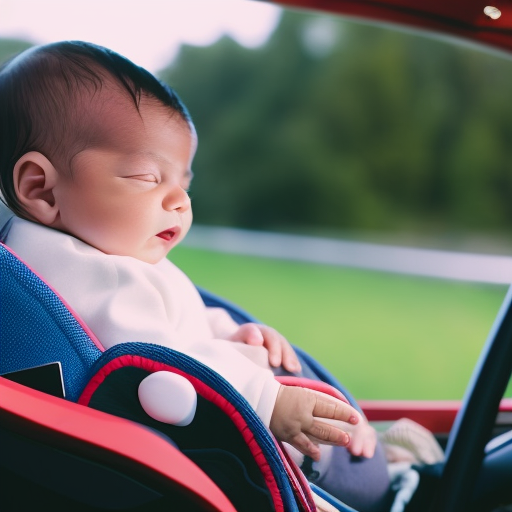
Make sure your newborn stays safe and comfortable during long car rides with these essential tips.
-
Plan for breaks:
Long car rides can be tiring for both you and your baby. Plan regular breaks to stretch your legs, change diapers, and feed your little one. This will help keep your baby calm and happy throughout the journey. -
Use recommended car seat accessories:
Invest in accessories that can make your baby’s car seat more comfortable. Consider using a padded insert or head support to provide extra cushioning and support for your newborn. Additionally, a car seat mirror can help you keep an eye on your baby without turning around, ensuring their safety while driving. -
Tips for soothing your newborn:
Long car rides can sometimes be overwhelming for newborns. To keep them calm, try playing soft music, using a white noise machine, or bringing along their favorite toys or blankets. You can also consider placing a sunshade on the window to block out excess sunlight and create a more soothing environment.
Transitioning From an Infant Car Seat
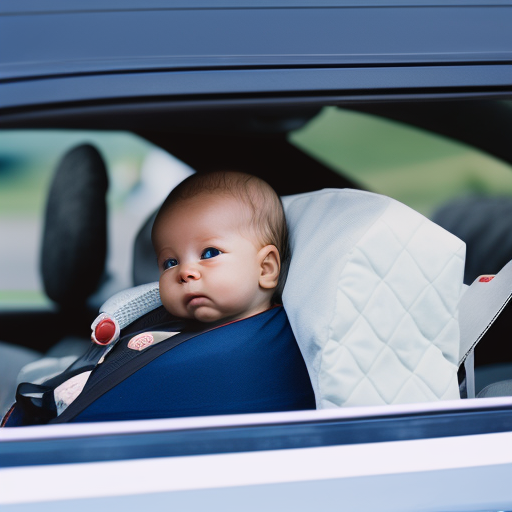
When your baby reaches a certain weight or height, it’s time to consider transitioning from an infant car seat. Knowing when to switch car seats can be a bit confusing, but there are a few key factors to consider.
The first thing to look for is your baby’s weight. Most infant car seats have a weight limit of around 30 pounds, so if your baby exceeds this limit, it’s time to move on to a convertible car seat.
Additionally, if your baby’s head is within an inch of the top of the car seat, it’s time for a switch. Another important factor to consider is your baby’s overall height. If your baby’s head is above the top of the car seat, it’s time to upgrade.
It’s crucial to remember that the transition should happen when your baby meets the height or weight limit of the infant car seat, not necessarily when they turn one year old.
Following these transitioning tips will ensure your baby’s safety on the road.
Extended Rear-Facing: Is It Necessary
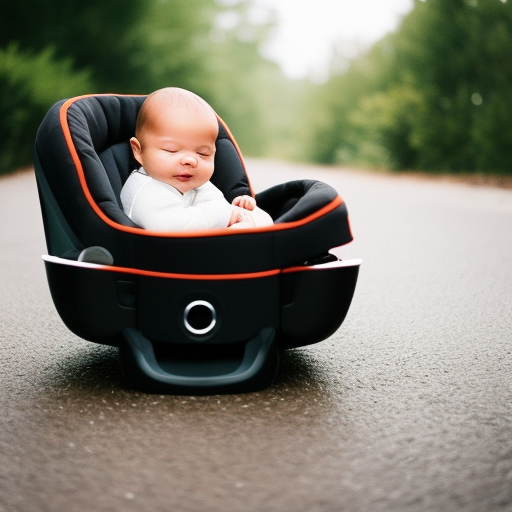
Consider the importance of extended rear-facing for your newborn’s car seat safety. While it may seem tempting to transition your baby to a forward-facing position as soon as they reach the minimum weight and height requirements, there are several benefits to keeping them rear-facing for an extended period of time.
-
Enhanced Protection: Rear-facing car seats provide better protection for your baby’s head, neck, and spine in the event of a crash. This is because the force of impact is distributed more evenly across their entire back, reducing the risk of serious injuries.
-
Reduced Risk of Injury: Studies have shown that children who remain rear-facing are less likely to sustain severe injuries in car accidents. The extended rear-facing position helps to absorb the impact and prevent the head from moving forward forcefully, which can cause neck and spinal injuries.
-
Myth Debunked: One common myth is that older children will be uncomfortable or have their legs cramped when rear-facing. However, car seats are designed to accommodate growing children in this position comfortably. Their legs can bend and stretch without causing any harm.
Staying Up-To-Date With Car Seat Safety Standards

To ensure your newborn’s car seat safety, it’s important to stay up-to-date with the latest car seat safety standards. Car seat safety regulations are constantly evolving as new research emerges, so it’s crucial to stay informed. Keeping up with these standards will help you make informed decisions and ensure that your newborn is protected while on the road.
Car seat safety research plays a vital role in establishing these standards. Researchers continuously study crash tests, accident data, and child injury statistics to determine the safest practices for newborns. By staying up-to-date with the latest research, you can ensure that your car seat meets the most current safety guidelines.
To stay informed, regularly check for updates from reputable sources such as the National Highway Traffic Safety Administration (NHTSA) or the American Academy of Pediatrics (AAP). These organizations often release new guidelines and recommendations based on the latest research findings.
Additionally, consider attending car seat safety workshops or consulting with certified child passenger safety technicians. They can provide you with valuable information on the proper installation and usage of car seats, ensuring that you’re following the most up-to-date safety standards.
Frequently Asked Questions
How Often Should I Replace My Newborn’s Car Seat?
You should replace your newborn’s car seat according to car seat expiration guidelines. It’s essential for car seat safety to ensure that the seat is still within its valid usage period to protect your precious little one.
Can I Use a Second-Hand Car Seat for My Newborn?
You should never use a second-hand car seat for your newborn. It’s important to prioritize their safety. Second-hand car seats may have expired or been involved in accidents, compromising their effectiveness and protection. Always install a new car seat properly.
What Is the Safest Place in the Car for My Newborn’s Car Seat?
The safest position for your newborn’s car seat is in the back seat, preferably in the middle. Proper installation is crucial, so follow the manufacturer’s instructions carefully to ensure your baby’s safety.
Can I Use a Car Seat Insert for My Newborn?
Yes, you can use a car seat insert for your newborn. It provides extra support and comfort. However, keep in mind that there are alternative options like rolled towels or blankets that can also provide adequate support.
When Can I Switch My Newborn to a Forward-Facing Car Seat?
You should not switch your newborn to a forward-facing car seat until they have outgrown the weight and height limits specified by car seat regulations. It is important to keep them in a rear-facing seat for as long as possible to ensure their safety.
Conclusion
In conclusion, car seat safety for newborns is of utmost importance to protect their fragile bodies during car rides. By choosing the right car seat, understanding rear-facing positioning, and properly installing it, you can ensure the utmost safety for your little one.
Remember to secure your newborn snugly in the car seat and follow safety tips for long journeys. Stay updated with car seat safety standards to provide the best protection for your child.
Don’t take any chances when it comes to your baby’s safety on the road.


